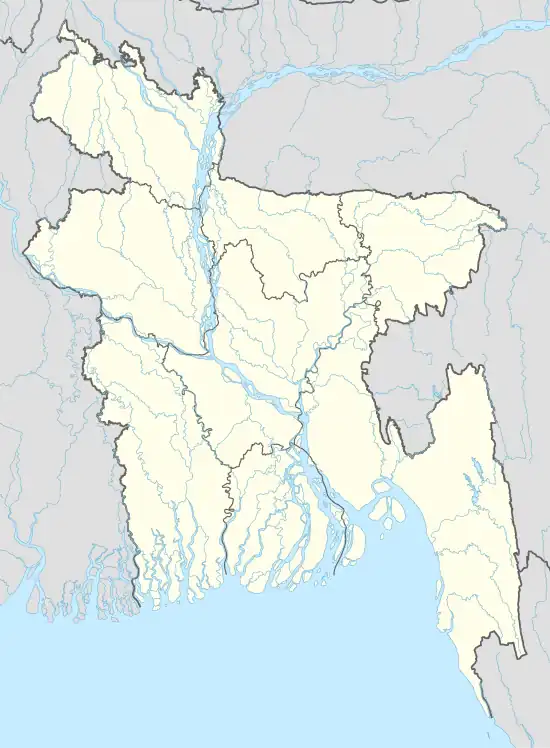Rajoir Upazila
Rajoir (Bengali: রাজৈর) is an upazila of Madaripur District in the Division of Dhaka, Bangladesh.
Rajoir
রাজৈর | |
|---|---|
 Rajoir Location in Bangladesh | |
| Coordinates: 23°12.5′N 90°2′E | |
| Country | |
| Division | Dhaka Division |
| District | Madaripur District |
| Area | |
| • Total | 229.29 km2 (88.53 sq mi) |
| Population (1991) | |
| • Total | 204,356 |
| • Density | 890/km2 (2,300/sq mi) |
| Time zone | UTC+6 (BST) |
| Website | rajoir |
Geography
Rajoir is located at 23.2083°N 90.0333°E. It has 37746 households and total area 229.29 km2. It is bounded by Bhanga upazila on the north, Kotalipara and Gopalganj sadar upazilas on the south, Madaripur sadar and Shibchar upazilas on the east, Muksudpur and Gopalganj Sadar upazilas on the west.
Population Total 218095; male 110233, female 107862; Muslim 146727, Hindu 70393, Buddhist 962 and others 13.
Demographics
According to the 2001 Bangladesh census, Rajoir had a population of 218,095, including 110,233 males, 107,862 females; 146,727 Muslims, 70,393 Hindus, 962 Buddhists and 13 others.[1]
As of the 1991 Bangladesh census, Rajoir had a population of 204356. Males constituted 50.3% of the population, and females 49.7%. This Upazila's eighteen up population was 99620. Rajoir had an average literacy rate of 28.5% (7+ years), and the national average of 32.4% literate.[2]
Points of interest
Raja Ram Temple, a two-storied brick Hindu temple in the village of Khalia, dates from the 17th century. The center room of the upper story has a do-chala roof, while the rooms on either side have char-chala roofs.[3]
Administration
Rajoir Thana, now an upazila, was formed in 1914.[4]
The upazila is divided into 11 union parishads: Amgram, Badar Pasha, Bajitpur, Haridasdi Mahendradi, Hosainpur, Isibpur, Kabirajpur, Kadambari, Khalia, Paik Para, and Rajoir. The union parishads are subdivided into 95 mauzas and 187 villages.[5]
Education
According to Banglapedia, Aruakandi-Natakhola-Barakhola High School, founded in 1963, is a notable secondary school in the upazila.[6]
References
- "Rajoir Upazila - Banglapedia". en.banglapedia.org. Retrieved 2023-03-31.
- "Population Census Wing, BBS". Archived from the original on 2005-03-27. Retrieved November 10, 2006.
- Ahmed, Babu; Chowdhury, Nazly (2005). Selected Hindu Temples of Bangladesh (PDF). UNESCO. p. 34. ISBN 984-32-1778-0. Retrieved 2017-08-24.
- "Rajoir Upazila - Banglapedia". en.banglapedia.org. Retrieved 2023-03-31.
- "District Statistics 2011: Madaripur" (PDF). Bangladesh Bureau of Statistics. Archived from the original (PDF) on 13 November 2014. Retrieved 14 July 2014.
- Chakrabarty, Kalyani Rani (2012). "Rajoir Upazila". In Islam, Sirajul; Jamal, Ahmed A. (eds.). Banglapedia: National Encyclopedia of Bangladesh (Second ed.). Asiatic Society of Bangladesh.
